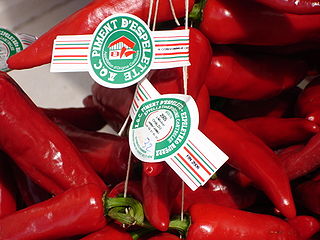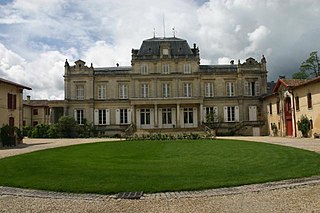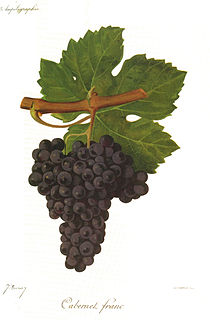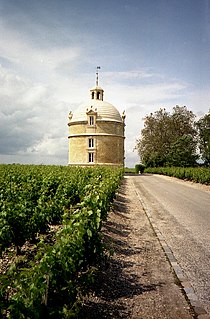
Château Latour is a French wine estate, rated as a First Growth under the 1855 Bordeaux Classification, owned by Groupe Artemis. Latour lies at the very southeastern tip of the commune of Pauillac in the Médoc region to the north-west of Bordeaux, at its border with Saint-Julien, and only a few hundred metres from the banks of the Gironde estuary.

Château Margaux, archaically La Mothe de Margaux, is a wine estate of Bordeaux wine, and was one of four wines to achieve Premier cru status in the Bordeaux Classification of 1855. The estate's best wines are very expensive, with a standard-sized bottle of the Château Margaux grand vin retailing at an average price of $639. The estate is located in the commune of Margaux on the left bank of the Garonne estuary in the Médoc region, in the département of Gironde, and the wine is delimited to the AOC of Margaux.
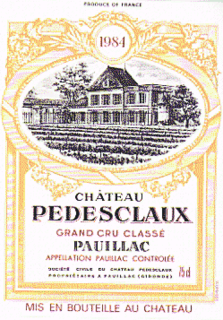
Château Pédesclaux is a winery in the Pauillac appellation of the Bordeaux region of France. The wine produced here was classified as one of eighteen Cinquièmes Crus in the Bordeaux Wine Official Classification of 1855.
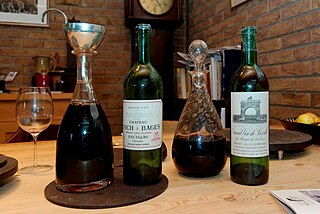
Château Léoville-Las Cases is a winery in the Saint-Julien appellation of the Bordeaux region of France. Château Léoville-Las Cases is also the name of the red wine produced by this property. The wine produced here was classified as one of fifteen Deuxièmes Crus in the original Bordeaux Wine Official Classification of 1855.
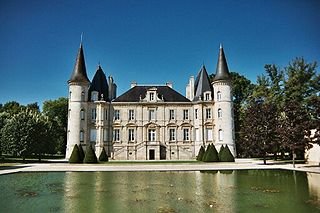
Château Pichon Longueville Baron or Château Longueville au Baron de Pichon-Longueville is a winery in the Pauillac appellation of the Bordeaux region of France. Château Pichon Longueville Baron is also the name of the red wine produced by this property. The wine produced here was classified as one of fifteen Deuxièmes Crus in the original Bordeaux Wine Official Classification of 1855.
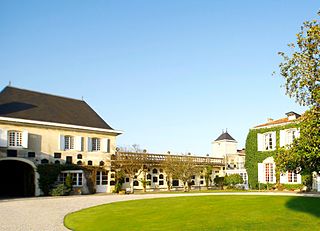
Château Prieuré-Lichine, previously Château Le Prieuré and Château Prieuré-Cantenac, is a winery in the Margaux appellation of the Bordeaux region of France, in the commune of Cantenac. The wine produced here was classified as one of ten Quatrièmes Crus in the historic Bordeaux Wine Official Classification of 1855.
Château Brane-Cantenac is a winery in the Margaux appellation of the Bordeaux wine region of France. The wine produced here was classified as one of fifteen Deuxièmes Crus in the original Bordeaux Wine Official Classification of 1855.
Château Cantemerle is a winery in the Haut-Médoc appellation of the Bordeaux wine region of France, in the commune of Macau. The wine produced here was the final estate to be classified as one of eighteen Cinquièmes Crus in the Bordeaux Wine Official Classification of 1855. Its absence from the classification map featured at the 1855 Exposition Universelle de Paris created some controversy, even though it has been listed on all maps published after 1855. Some sources will include an asterisk next to Château Cantemerle listing in reference to this controversy. The estate has a long history in the Haut-Médoc with records detailing its existence since at least the 12th century and wine production since at least the 14th century. In the 19th century, the estate was hard hit by the phylloxera epidemic as well as grapevine attacks of downy mildew, after which production dropped nearly 50%. Towards the end of the 20th century, the estate was sold to French insurance group Les Mutuelles d'Assurance du Bâtiment et des Travaux Public who have contributed significant investment in the estate's vineyards and winemaking facilities.
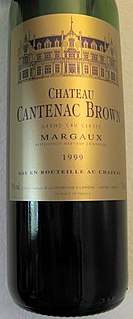
Château Cantenac-Brown is a winery in the Margaux appellation of the Bordeaux region of France. The wine produced here was classified as one of fourteen Troisièmes Crus in the historic Bordeaux Wine Official Classification of 1855. The Château has 118 acres (0.48 km2) planted with Cabernet Sauvignon, Merlot and Cabernet Franc. The Château produces a second wine labeled as Brio de Cantenac-Brown.
Château Calon-Ségur is a winery in the Saint-Estèphe appellation of the Bordeaux wine region of France. The wine produced here was classified as one of fourteen Troisièmes Crus Classés in the historic Bordeaux Wine Official Classification of 1855. It is the northernmost classified growth in the Médoc.
Château Ferrière is a winery in the Margaux appellation of the Bordeaux region of France. The wine produced here was classified as one of fourteen Troisièmes Crus in the historic Bordeaux Wine Official Classification of 1855. The Château has 29 acres (12 ha) planted with Cabernet Sauvignon, Merlot and Cabernet Franc.

Château Saint-Pierre is a winery in the Saint-Julien appellation of the Bordeaux region of France. The wine produced here was classified as one of ten Quatrièmes Crus Classés in the historic Bordeaux Wine Official Classification of 1855.
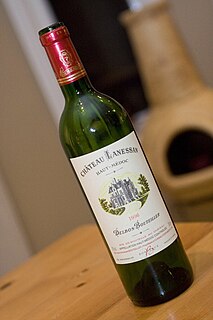
Château Lanessan is a Bordeaux wine estate in the Haut-Médoc appellation, located on the Left Bank of France’s Bordeaux wine regions in the commune of Cussac near Fort Médoc. The estate held a rating of Cru Bourgeois Supérieur, until this specific classification was annulled. Some critics have suggested that it ought to be elevated to a higher classification.

Château Gloria is an unclassed Bordeaux wine from the Saint-Julien appellation. The winery is located in the central part of France’s Bordeaux wine region Haut-Médoc, in the commune of Saint-Julien-Beychevelle.

Château Sigalas-Rabaud, previously also named Château Rabaud-Sigalas, is a Bordeaux wine producer in the Sauternes appellation. Its sweet white wine ranked as Premier Cru Classé in the original Bordeaux Wine Official Classification of 1855. It is located in the commune of Bommes in the region of Graves. It was once joined with Château Rabaud-Promis in the estate named Château Rabaud. With only 14 hectares, Château Sigalas-Rabaud is the smallest of all crus classés of the 1855 classification.
Château d'Angludet or Château Angludet, is a Bordeaux wine estate in the appellation Margaux, in the commune of Cantenac on the left bank of the Gironde. The estate was classified a Cru Bourgeois Exceptionnel in 1932, and most recently a Cru Bourgeois Supérieur in 2003, in a classification which has been inactive since 2007.
Château Marojallia is a Bordeaux winery belonging to the appellation Margaux, in the commune of Arsac. A "microcuvée", the wine produced has been described as Médoc's first "garage wine".
Château La Tour de Mons, archaically named Tour de Marsac, is a winery and wine from the appellation Margaux, located in the Left Bank of the Bordeaux wine region of France, in the commune of Soussans. The wine was rated Cru Supérieur in the Cru Bourgeois classification of 1932, and through later revisions until the temporary annulment of the classification in 2007.
Château Rauzan-Ségla, or Château Rausan-Ségla, is a winery in the Margaux appellation of the Bordeaux region of France. Château Rauzan-Ségla is also the name of the red wine produced by this property. The wine produced here was classified as one of fifteen Deuxièmes Crus in the original Bordeaux Wine Official Classification of 1855. The alternate name "Rausan-Ségla" was also frequently used until 1994 when the original "Rauzan-Ségla" again became the official name.
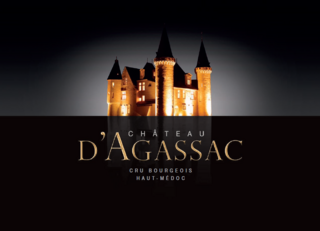
Château D'Agassac is a Haut-Médoc wine estate located on the village of Ludon-Médoc in the Médoc, only 15 minutes from the city of Bordeaux in France. Its red wine is a famous Cru Bourgeois ranked "Cru Bourgeois Exceptionnel" in the historic Bordeaux Wine Official Classification of 1932. The property is also a leader in enotourism.



